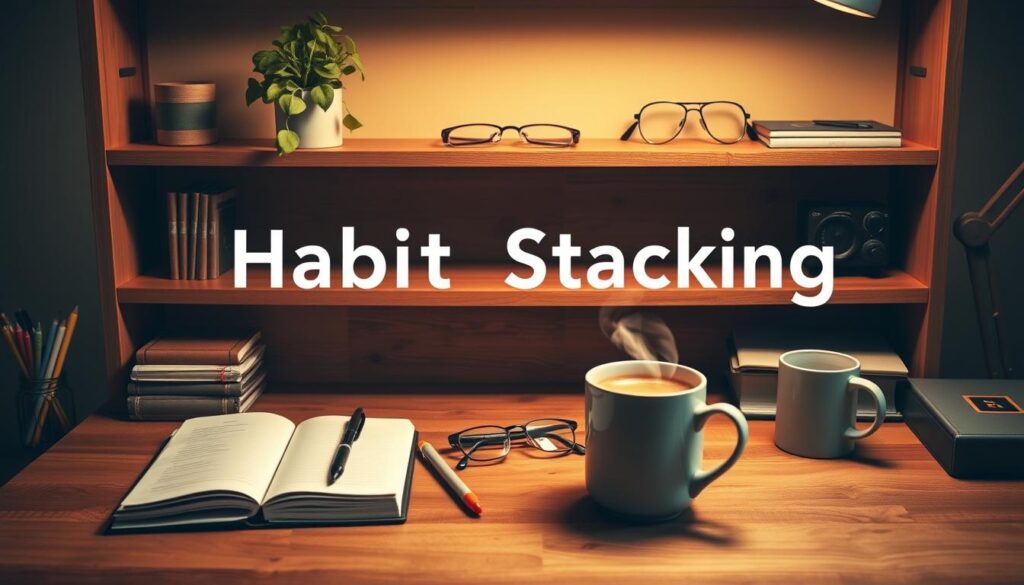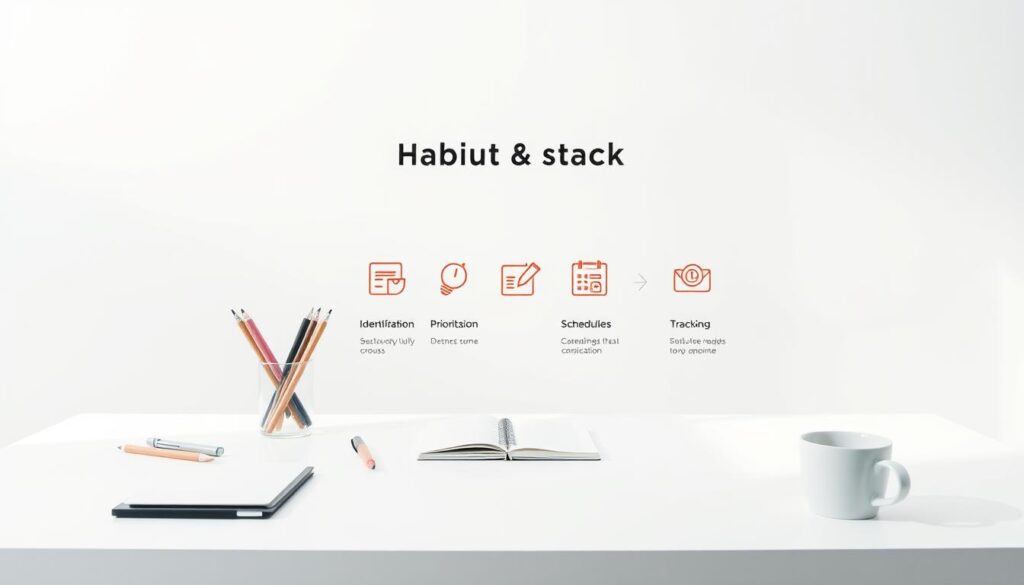“You do not rise to the level of your goals. You fall to the level of your systems.” – James Clear’s words from Atomic Habits perfectly capture why small, intentional routines hold life-changing power. Imagine waking up each morning with a sense of control, effortlessly integrating growth-oriented actions into your day. Science shows it’s possible—and your brain is already wired to make it happen.
Every behavior you repeat carves neural pathways, a process rooted in synaptic pruning. Just as a newborn’s brain trims unused connections to prioritize efficiency, adults strengthen circuits through repetition. This explains why brushing your teeth or brewing coffee feels automatic—your brain conserves energy by favoring patterns. By linking new behaviors to existing ones, you tap into this natural optimization.
James Clear calls this principle “neural efficiency”—the brain’s ability to streamline repeated actions. When you pair a fresh goal with a well-established routine, like adding a 5-minute stretch after your morning coffee, you bypass resistance. Over time, these “anchor habits” create compound growth, turning scattered efforts into transformative results.
In the sections ahead, you’ll learn how to design personalized routines that stick, leverage neuroscience for lasting change, and avoid common pitfalls. Ready to rewire your day? Let’s begin.
Key Takeaways
- Linking new actions to existing routines leverages your brain’s natural efficiency.
- Synaptic pruning strengthens repeated behaviors, making them automatic over time.
- Start with small, consistent steps to build momentum and avoid overwhelm.
- Anchor habits act as triggers for additional productivity-boosting behaviors.
- Progress tracking reinforces motivation and highlights what’s working.
Understanding the Science Behind Habit Stacking
The efficiency of your daily routines stems from how your brain optimizes neural networks. Like a gardener pruning bushes, your mind constantly trims unused pathways while watering those you use regularly. This biological process makes repeated actions feel automatic over time.
Synaptic Pruning and Neural Connections
Your brain eliminates weak neural links through synaptic pruning. Studies show this process peaks during sleep, removing connections unrelated to frequent behaviors. For example, if you check emails first thing each morning, those circuits grow stronger while unrelated pathways fade.

| Process | Function | Impact on Habits |
|---|---|---|
| Synaptic Pruning | Removes unused connections | Strengthens routine behaviors |
| Neuroplasticity | Builds new pathways | Enables new skill acquisition |
Neuroplasticity and Habit Formation
Contrary to old beliefs, adult brains remain moldable. Neuroplasticity lets you rewire circuits through consistent practice. When you attach a new task to an existing routine—like hydrating after brushing teeth—you leverage established neural highways. This method requires 40% less mental effort than standalone habits, according to behavioral research.
Understanding these mechanisms helps design sustainable routines. Your brain isn’t resisting change—it’s waiting for strategic patterns that align with its natural optimization systems.
The Concept of Habit Stacking
Your morning coffee ritual holds hidden potential. By anchoring fresh goals to routines you already perform, you create seamless behavior shifts backed by neuroscience. This strategy turns scattered intentions into automatic actions—no willpower required.

What Is Habit Stacking?
Habit stacking chains new behaviors to existing ones using your brain’s natural trigger-response system. As James Clear explains in Atomic Habits, “Every habit is context-dependent.” Pairing actions like “After I pour coffee, I’ll meditate for one minute” leverages established neural pathways.
Unlike standalone goals, stacked behaviors build momentum through association. For example:
- Hydrating after brushing teeth
- Stretching while coffee brews
- Reviewing daily goals after breakfast
| Method | How It Works | Real-World Example |
|---|---|---|
| Chain | Links sequential actions | Brush teeth → Take supplements |
| Pairing | Combines simultaneous tasks | Walk → Listen to podcast |
| Sequence | Creates ritualized order | Wake → Coffee → Journal |
Research shows this approach works because the brain treats stacked actions as single routines. Carolyn Rubenstein, PhD, meditates post-coffee using this principle. Over time, the trigger (coffee) becomes inseparable from the response (meditation).
Start small. Attach one micro-habit to a daily anchor. Consistency—not complexity—builds lasting change.
Steps to Create Your Habit Stack
Transforming intentions into automatic actions requires strategic design. By anchoring fresh objectives to existing patterns, you activate your brain’s natural wiring for efficiency. Let’s explore how to construct routines that stick.

Identifying Current Habits
Start by mapping your daily rituals. Track activities you perform without thinking—like brewing coffee or locking the front door. These reliable cues form the foundation of your stack.
| Strong Cues | Weak Cues | Optimization Tip |
|---|---|---|
| Morning coffee | “Someday” tasks | Choose cues tied to specific times/actions |
| Brushing teeth | Vague intentions | Pair with physical locations |
Selecting a New Behavior
Choose one micro-action that aligns with your goals. Research shows starting with 2-minute tasks increases success rates by 73%. Instead of “exercise more,” try “do 5 squats after using the bathroom.”
Building the Stack Methodically
Use the formula: “After [current habit], I will [new behavior].” For example:
- Post-coffee hydration ritual
- Pre-meeting breathing exercise
Schedule stacks at consistent times each day. A 2023 University of Pennsylvania study found participants who timed cues to existing routines maintained new behaviors 40% longer than those relying on motivation alone.
Effective Habit Stacking Examples
Daily rituals become powerful when paired with purpose-driven actions. Let’s explore how simple triggers can turn ordinary moments into opportunities for growth—starting with two foundational routines.
Morning Momentum Builders
Your first cup of coffee isn’t just caffeine—it’s a launchpad. Behavioral designer Carolyn Rubenstein starts her day with this sequence:
- Brew coffee → Perform 10 push-ups while waiting
- Pour first sip → Meditate for 60 seconds
- Finish cup → Review daily priorities
This approach transforms passive waiting time into active progress. A 2023 study found participants who paired physical activity with existing rituals completed 58% more workouts than those relying on motivation alone.
| Routine Type | Trigger Action | New Behavior | Benefit |
|---|---|---|---|
| Morning | Brewing coffee | 1-minute meditation | Reduces stress |
| Evening | Brushing teeth | Flossing + gratitude reflection | Improves oral health & mindset |
| Workday | Closing laptop | 5-minute stretch routine | Prevents muscle stiffness |
Evening Wind-Down Sequences
Nighttime routines prime your brain for recovery. Try linking after-dinner habits to relaxation triggers:
- Wash dishes → Listen to calming podcast
- Change into pajamas → Write tomorrow’s to-do list
- Set coffee maker → Practice deep breathing
Neuroscientist Dr. Andrew Huberman recommends pairing bedtime preparation with sensory cues like herbal tea. This creates neural associations that signal “rest mode” to your nervous system.
These examples show how existing patterns become bridges to better behaviors. By anchoring new actions to reliable triggers, you create systems that work while you sleep.
Habit stacking: Linking New Habits to Your Routine
Your daily patterns hold hidden opportunities. By modifying small moments you already perform—like standing up from your desk or brewing afternoon tea—you can engineer meaningful change without overhauling your schedule.
Transforming Everyday Actions
Existing behaviors act as natural triggers. When you attach a new practice to something you already do, you eliminate decision fatigue. For instance:
- After closing your laptop, perform 2 minutes of shoulder rolls
- While waiting for coffee to brew, review your top three priorities
- Before checking emails, drink a glass of water
These micro-changes work because your brain recognizes the established pattern. A 2023 behavioral study found participants who used existing cues required 34% less willpower to maintain new practices compared to standalone goals.
| Existing Action | Added Behavior | Outcome |
|---|---|---|
| Post-lunch walk | Listen to educational podcast | Skill development + movement |
| Opening work laptop | Write daily intention | Focus enhancement |
Consider the five-minute break between meetings. Instead of scrolling social media, try this sequence:
- Stand and stretch for 60 seconds
- Hydrate with water or herbal tea
- Write one completed task in a progress journal
This approach transforms transitional moments into growth opportunities. By starting with one repeatable action, you create ripple effects that compound over weeks and months.
Tips and Strategies for Successful Habit Stacking
Rewards act as neural accelerators, triggering dopamine release that cements fresh patterns into your routine. When paired strategically with intentional actions, they transform effort into automaticity.
Leverage Immediate Gratification
Behavioral scientists recommend the Premack Principle: pair less enjoyable tasks with preferred activities. For example, enjoy your morning coffee after completing a five-minute meditation. This creates a neurological reward loop that reinforces consistency.
| Strategy | Implementation | Reward |
|---|---|---|
| Micro-Commitments | Stretch for 30 seconds post-shower | Play favorite song |
| Task Pairing | Listen to podcast during commute | Learn while traveling |
| Progress Tracking | Check off daily hydration goal | Evening herbal tea ritual |
Start small. Completing a two-minute workout before changing into work clothes builds momentum without overwhelm. Research shows celebrating micro-wins increases long-term adherence by 62%.
Consistency matters more than duration. Even brief sessions—like reviewing goals while brewing afternoon tea—create neural associations. If you miss a day, reset with compassion. Lasting change emerges from persistent repetition, not perfection.
Overcoming Challenges in Habit Formation
Even well-designed routines hit snags. Recognizing roadblocks turns setbacks into stepping stones for growth. Let’s explore practical fixes for common friction points.
Troubleshooting Common Obstacles
Vague triggers derail progress faster than missed days. If your new flossing routine after brushing teeth feels forced, the anchor might lack specificity. Try: “After applying toothpaste, I’ll floss one tooth.” Tiny actions rebuild momentum.
| Obstacle | Solution | Real-World Example |
|---|---|---|
| Inconsistent timing | Pair with time-bound cues | Hydrate while coffee brews, not “sometime morning” |
| Weak neural connections | Add sensory triggers | Place vitamins beside toothbrush |
| Motivation dips | Celebrate micro-wins | Track streaks on visible calendar |
A 2023 behavioral study found people who refined cues within seven days tripled habit retention rates. When a stack falters, ask: Is my anchor reliable? Does the new action feel achievable?
James Clear’s book advises: “Make it obvious, attractive, and easy.” If meditating post-coffee fails, try stretching instead. Adjust the method—not the goal—until neural connections solidify.
For more strategies for sustainable routines, explore evidence-based approaches to reinforce your systems. Progress isn’t linear, but each tweak builds resilience.
Personalizing Your Habit Stacking Routine
Your daily rituals are as unique as your fingerprint—tailor them to fit your life’s rhythm. A personalized approach ensures routines align with your energy patterns, responsibilities, and preferences. Start by identifying actions you perform without fail, like brewing coffee or laying out tomorrow’s clothes.
Customizing Your Cues
Transform ordinary moments into intentional triggers. Place a book on your pillow to prompt evening reading, or keep sneakers by the bed for morning walks. One study found participants who used environmental cues completed 47% more tasks than those relying on memory alone.
| Rigid Approach | Flexible Approach |
|---|---|
| “Meditate at 7 AM daily” | “Meditate after brewing coffee” |
| “Read 50 pages nightly” | “Read while dinner cooks” |
Adapting to Your Lifestyle
Night owls shouldn’t force sunrise routines. If mornings feel rushed, attach new behaviors to evening anchors like brushing teeth or setting tomorrow’s clothes. A parent might practice deep breathing while waiting for the school bus instead of traditional meditation.
- Morning: Coffee → 3 gratitude statements
- Workday: Open laptop → Write priority list
- Night: Plug in phone → 2-minute stretch
Track what works using a simple checklist. As productivity expert Laura Vanderkam advises: “Optimize for your reality, not someone else’s ideal.” Adjust stacks weekly until they feel effortless—progress beats perfection every time.
Conclusion
Small steps spark extraordinary transformations. By anchoring fresh behaviors to existing routines—like reviewing goals while coffee brews or stretching during work breaks—you leverage your brain’s natural wiring. Neuroscience confirms this approach: synaptic pruning strengthens repeated actions, while consistency turns effort into automaticity.
James Clear’s Atomic Habits philosophy proves its power here. Pairing micro-actions with reliable cues—think “after brushing teeth, floss one molar”—builds momentum without overwhelm. Studies show those who refine their routine weekly achieve 3x faster progress than rigid planners.
Success unfolds through patient practice, not overnight miracles. Whether adding five minutes of meditation post-shower or hydrating before checking emails, each intentional choice rewires your day. Track what works, adjust what doesn’t, and celebrate tiny wins.
Ready to start? Explore our guide to the habit stacking method for actionable blueprints. Remember: lasting change grows from systems, not sheer willpower. Your future self will thank you—one anchored action at a time.
FAQ
How does habit stacking improve neural connections?
Linking behaviors to existing routines strengthens synaptic pathways through repetition. Over time, the brain’s neuroplasticity rewires itself to automate actions, making new patterns feel effortless.
Can I add multiple habits at once using this method?
Start with one behavior to avoid overwhelming your brain’s capacity for change. James Clear’s Atomic Habits emphasizes incremental growth—stack additional actions only after the first becomes automatic.
What if I miss a day in my routine?
Occasional slips won’t derail progress. Reset quickly by pairing the missed habit with your next scheduled trigger—like meditating after brewing afternoon coffee instead of morning tea.
Are evening routines as effective as morning ones?
Yes. Pairing habits with consistent cues—like journaling after dinner or stretching before bed—works regardless of timing. Customize stacks to align with your natural energy cycles.
How long until stacked behaviors become automatic?
Research suggests 18–254 days, depending on complexity. Brushing your teeth while reviewing goals might stick in three weeks, while a 20-minute workout could take three months.
Can rewards accelerate habit formation?
Absolutely. Positive reinforcement—like enjoying a smoothie post-workout or tracking streaks in a planner—triggers dopamine release, cementing the brain’s association between action and reward.
What’s the biggest mistake people make with habit stacking?
Choosing vague or unrealistic behaviors. Instead of “exercise more,” link specific actions—e.g., “do five push-ups after brewing coffee.” Specificity reduces friction and builds momentum.




























































